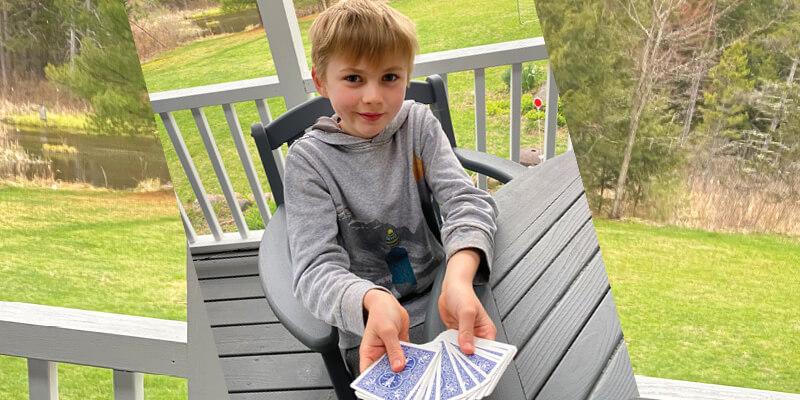“Pick a card, any card.”
That’s 10-year-old Silas Lofy, demonstrating a magic trick he learned in his speech-language pathology session on a recent Thursday afternoon. Silas meets weekly over Zoom with communication sciences and disorders professor Sharon Cote for help with his speech. Cote helps Silas practice his “R’s.” They play games or watch videos together and discuss the experience.
“We talk and I correct myself. I challenge her to pay close attention,” Silas said. “I like that I’m practicing with somebody and we do numerous things that are different each time and they are fun. I say words, and we play a ton of new games.”
Faculty and graduate students in the speech-language pathology (SLP) program typically meet with clients at UVM’s on-campus Eleanor M. Luse Center for Communications. Students engage with faculty supervisors to assess, diagnose and provide therapy for people with language and speech disorders, articulation delays, vocal cord disfunction, swallowing disorders and apraxia of speech due to stroke or brain injury.
To follow coronavirus-induced social distancing guidelines, UVM now offers SLP services remotely through Zoom. The online audio-video conferencing tool allows for telepractice — the application of telecommunications technology to link clinician to client. The transition to telepractice was fast and unsettling for some, but most caught on quickly.
“The best learning is when you jump in with two feet and just do it, and that’s what we’ve done. Students are technologically savvy, so they got it. Our clients are very thankful that their services get to continue,” Cote said.
Going forward, telepractice will increase access for people who live far from the clinic and for whom disease vulnerability or transportation remain barriers.
“The most exciting part about telepractice is the potential to reach underserved populations,” said Shira Habermehl, Communication Sciences and Disorders ’20. Now a graduate student pursuing a Master of Science to become a speech-language pathologist, Habermehl provides therapy for a child with selective mutism, an anxiety disorder in which a person is unable to speak in social situations. Adapting therapy for Zoom challenged Habermehl and proved a beneficial change for the client.
“I believe Zoom allowed her to take more speaking risks, because her bedroom is a familiar environment for her, compared to a clinic environment,” Habermehl said. “I made treatment plans to incorporate items in her room, such as scavenger hunts for items that we could then discuss. Telepractice kicked our creativity into full gear to adapt to this new way of service delivery.”
Graduate student Gwyn Gauthier found that remote therapy sessions involve greater preparation, resourcefulness and involvement of client’s families. Parents seem grateful, she said, and the children find it entertaining.
“We can put up games, pictures or videos for our clients to view or interact with,” Gauthier said. “A young client that I worked with was very excited when she found out that she could do an online Frozen puzzle as a reinforcing activity!”
UVM students appreciate the opportunity to take on telepractice during the pandemic’s forced physical distancing. “We are thankful that we can continue helping clients develop their communication skills, learning and growing as clinicians and gaining the hours that we need to complete the program,” Gauthier said.
Said Habermehl, “I’m glad that therapy can still be a constant for our clients amid a currently chaotic world.”
For Silas Lofy, Zoom sessions with professor Cote are the highlight of his week.
“Even though we are home he has something to look forward to, his Thursday afternoon visit with Sharon. Having that routine is comforting,” Bill Lofy said. “It’s a pretty remarkable thing to have your 10-year-old excited about his weekly speech sessions. They challenge each other and enjoy each other.”
